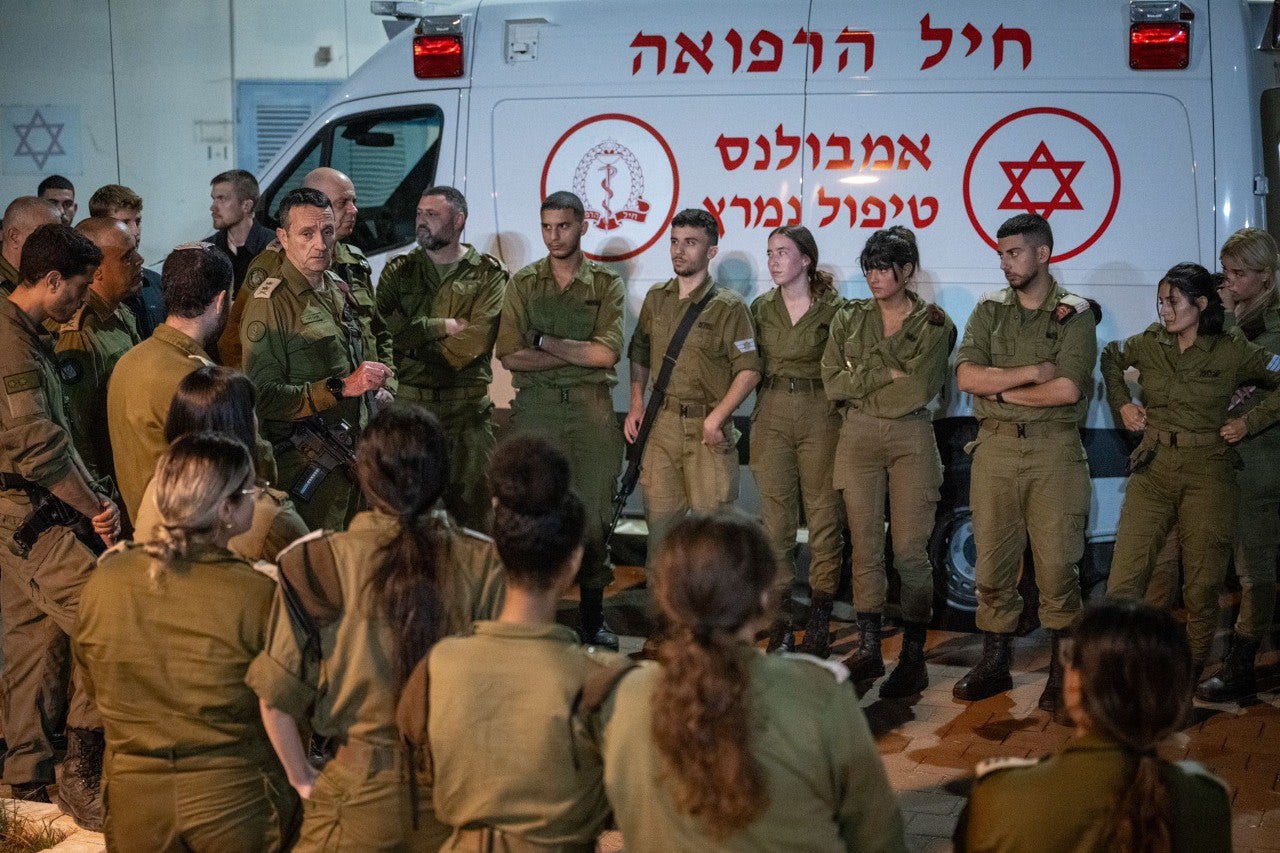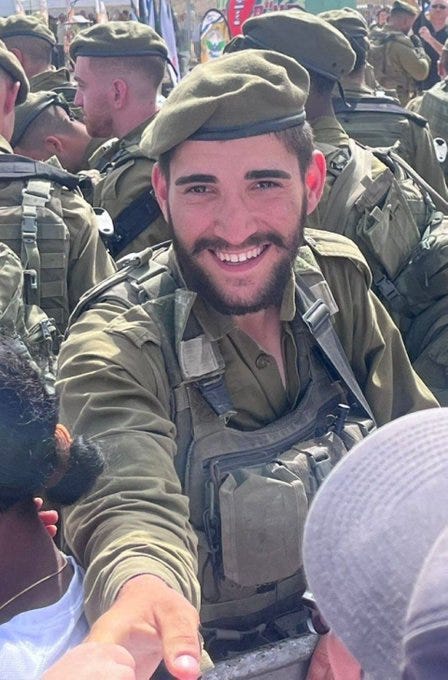DAY 374 OF THE WAR: Four Soldiers Laid To Rest, Soldier Killed In Gaza, Missile Attacks From Lebanon—Including in Tel Aviv, Hezbollah’s Underground Network Significantly Larger Than Expected
Tel Aviv Diary, October 14, 2024
DRONE ATTACK ON GOLANI BRIGADE TRAINING BASE
The morning unfolded as anticipated following last night's announcement of the casualties from the suicide drone strike on a base of the Golani Combat Brigade. The attack claimed the lives of four soldiers who were in basic training. The fallen include Sgt. Omri Tamari (19), from Mazkeret Batya; Sgt. Yosef Hieb, (19), from Tuba Zangariya; Sgt. Yoav Agmon, (19), from Binyamina-Giv’at Ada; and Sgt. Alon Amitay, (19), from Ramot Naftali. All were laid to rest today.
IDF Chief of Staff Herzi Halevi visited the Golani training base, the site of the recent drone strike, and said:
We are at war, and an attack on a training base in the periphery is harsh, and the consequences are painful. You operated well in treating and evacuating the wounded and injured. Embrace the bereaved families, support the injured, and strengthen the commanders and soldiers.
We continue to fight and train for what lies ahead. The Golani Brigade has achieved many successes in this war and has faced difficult situations with determination. Follow the path [of your brigade’s] legacy.
The Air Force has issued a preliminary report concerning the recent tragic incident. According to the report, Hezbollah launched three drones towards Israel from off the coast. The first drone was neutralized by a Navy ship, the second was intercepted by the Iron Dome system, and the third initially vanished from radar, presumed to have crashed. For a brief moment, it reappeared on radar, when it was mistakenly identified as a bird. Ground observers noticed the drone approximately ten minutes before the strike, but the Air Force, believing it to be an IAF helicopter in the vicinity, dismissed it. Ultimately, the drone continued its course to the Golani base and struck the dining hall roof during dinner.
In addition, the Air Force has also published statistics concerning drone attacks. Since the onset of the war, 1,200 drones have been directed towards Israel. According to IAF records, 82% of these drones were either successfully intercepted or failed to reach their targets due to various other factors.
Numerous questions are now being raised. What is evident is that after a year of war, we have yet to devise an effective response to the drone threat. Indeed, we can intercept many of them; just this morning, the Israeli Air Force (IAF) downed two drones originating from Syria. However, our capacity to both track and intercept drones remains inadequate. As recently as last Friday night, a drone successfully penetrated our airspace, reaching all the way to Herzliya.
The Ukrainians rely heavily on acoustic methods to track drones, a tactic we do not appear to be utilizing widely, if at all. The Ukrainians primarily employ machine guns to shoot down drones, whereas we depend on extremely expensive interceptors. There has been discussion of reintroducing Vulcan guns, which served as a component of aerial defense before the Air Force transitioned to reliance on missiles. To the best of my knowledge, reinstatement of the Vulcan guns has not yet occurred.
While all of this highlights the challenges we still face, it’s important to remember how far we’ve come. During the 2006 Lebanon war, we had no defense against rockets. Every rocket that fell caused damage and often resulted in casualties. Today, despite the thousands of rockets (and ballistic missiles) fired, the number of people wounded or killed has been remarkably low, thanks to our extensive, world-class rocket defenses.
Earlier today, a barrage of ten rockets was fired at Haifa, and all but one was intercepted—a rocket that landed in an open area. A short time later, another barrage of five rockets was launched toward central Israel near Netanya, and all were successfully intercepted by the Air Force. Late this afternoon, I was walking my dog, Milo, when my watch began vibrating, signaling rocket warnings nearby, though none were issued for central Tel Aviv. I could hear distant sirens, but none in my immediate vicinity. I decided to head home, but before I got too far, the sirens sounded right where I was.
I asked a man on the street to point out the closest shelter, and he immediately pointed to a nearby building. We hurried inside, and I coaxed Milo down a narrow staircase to the building's basement bomb shelter. Inside, I joined about 20 other people—residents of the building and some, like me, just passing by, including approximately six small children. The adult supervising the children got them to sing a little, which lightened the mood. After about 15 minutes, we left the shelter. Milo, who had been well-behaved inside, was clearly relieved to dash up the stairs and out into the open. I later learned that three missiles had been fired toward the Tel Aviv, two were intercepted, and one landed in open terrain.
A pressing question resonates throughout Israel tonight: Has Hezbollah rebounded from the initial setbacks Israel inflicted on their terror forces in the first week of the Lebanese campaign? It certainly seems Hezbollah is regrouping. Although they have yet to launch large-scale barrages towards the country’s center, the growing frequency and coordination of their attacks mark a worrying escalation.
GAZA
Fighting continued today in Gaza, both in Jabalya in the North, and along the Philadelphi Corridor, where Israeli soldiers came under attack. In one such attack, Sergeant Koren Bitan (19), was killed. Additionally, a concerted effort was made today to facilitate the entry of food trucks into northern Gaza, addressing the UN’s claims regarding food shortages in that region
.
Today, the IDF confirmed the elimination of another Hamas commander in operations conducted in September.
Here’s the statement released by the IDF Spokesman today regarding the elimination
During September 2024, Israeli Air Force fighter jets, under the guidance of Military Intelligence, the Shin Bet, and the Air Force, attacked and eliminated Samer Abu-Daqa, the head of Hamas’ aerial system, who replaced the previous head of the aerial system, eliminated in October 2023.
Abu-Daqa was responsible for many aerial terrorist operations, including the launching of drones and UAVs towards the territory of the State of Israel and IDF forces. Abu-Daqa was a key knowledge figure in Hamas’ aerial system and played a central role in its establishment. He was one of those responsible for the infiltration of para-gliders and unmanned aircraft into Israeli territory during the brutal massacre on October 7.
In the past, Abu-Daqa served as the head of Hamas’ UAV system until the “Guardian of the Walls” operation in May 2021. In addition, Abu-Daqa oversaw the production of weapons at Hamas’ manufacturing headquarters. He played a central role in the development of projects and infrastructures as part of the growth of Hamas’ aerial system in the Gaza Strip.
IN THE NORTH
The Army has intensified its operations in southern Lebanon, advancing beyond the initial row of Lebanese villages to at least the second line. There, the IDF has uncovered massive command bunkers capable of holding hundreds of Hezbollah fighters. These bunkers and tunnels are on a completely different scale than those used by Hamas. Israel clearly cannot stop until all these Hezbollah tunnels are located and destroyed. Although these tunnels are not concealed in the same manner as those in Gaza, eliminating them will require considerably more sophisticated engineering solutions.
Today, the IDF announced that it had eliminated Mohammed Kamel Naim, Commander of the anti-tank missile unit within Hezbollah's Radwan force. Naim was targeted and killed during an operation in Nabatiyeh. He was implicated as the
Keep reading with a 7-day free trial
Subscribe to Tel Aviv Diary to keep reading this post and get 7 days of free access to the full post archives.






